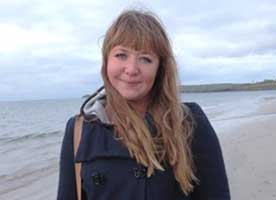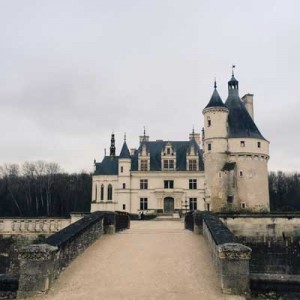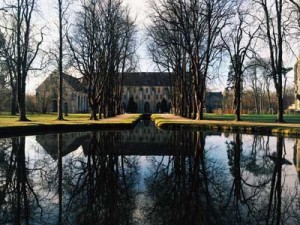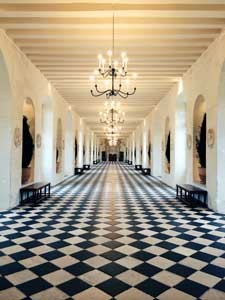 by Dr Marianna Dudley, University of Bristol. Cross-posted from The Power and the Water: Connecting Pasts with Futures blog
by Dr Marianna Dudley, University of Bristol. Cross-posted from The Power and the Water: Connecting Pasts with Futures blog
Between cultural and natural heritage
Chenonceau is a chateau worthy of a fairytale princess. It has turrets and gardens and galleries – and a river running through it. Built between 1514 and 1522 on the site of an old mill, it became the home of Diane de Poitiers, mistress of King Henry II. Diane loved the chateau, and built the bridge over the river. On Henry’s death in 1559, his widow Catherine de Medici demanded that Diane exchange Chenonceau for her chateau Charmont. Catherine built the galleries upon Diane’s bridge, and ruled France as regent from the building. Renaissance intrigues, not fairytales, brought this building to life.
I was in France following an AHRC-Labex Franco-British workshop, where Care for the Future project members were brought together with French Labex counterparts, to discover each other’s research and discuss possibilities for future collaboration. The 2-day workshop was held in a former abbey transformed into a cultural centre – the Royaumont Foundation – to the north of Paris, a stunning setting for the ‘Delving Back into the Past to Look into the Present’ workshop.
The workshop was the result of an initiative by Andrew Thompson, director of the Care for the Future programme for the AHRC in Britain, and Ghislaine Glasson Deschaumes, director of Les Passés dans le présent (the Laboratoire d’excellence based at the Université Paris Ouest Nanterre la Defense, France). The two funding schemes had such close themes – Care for the Future: Thinking Forward through the Past, and The Past in the Present: History, Patrimony, Memory – as well as an emphasis on working with external heritage partners, and supporting early career researchers, that Andrew and Ghislaine have taken the opportunity to forge collaborative links between the two. Future funding will allow members of the two schemes to connect and apply for funding for joint research projects.
Carry van Lieshout and I were there to represent ‘The Power and the Water’, describe our research and be alert for potential links with French researchers present. My paper, ‘Between natural and cultural heritage, and human and natural archive’, discussed the importance of placing environments and natures at the heart of our understandings of heritage – as they have been historically, for example in the conservation movement in the UK and the global national park movement. It suggested that the language of heritage acquires new meaning when situated in a public sphere with many and multiple ties to place and nature – heritage breeds, heirloom vegetables, and keystone species are just some of the vocabulary used to add value to things by invoking heritage both cultural and natural. I suggested that, as historians and heritage professionals, we should be alert to the natural archive as a source and site for history, in addition to the cultural archive, and continue to place importance on landscapes, animals, ecosystems, natural cycles – and the histories and cultures they inform – in our discussions of heritage. In her paper ‘River or Ruin? Connecting Histories with Publics’, Carry explored how different valuations and understandings of an intermittent river and its heritage are playing out in the Peak district, and suggested that to widen our understanding (and expectations) of heritage-in-place to accommodate both natural and human interventions might allow contestations between past, present and future use to move forward.
After an intense two days of workshopping, I took some time to see more of French heritage in situ. Thus, I ended up at Chateau Chenonceau on a bitterly cold January morning, fully absorbed in the Renaissance splendor of the house, from the kitchens down below to the roaring fires that brought life (and much-needed warmth) to bed chambers and sitting rooms. This was cultural heritage at its best.
But then, in the gallery exhibition, a quote from Marguerite Yourcenar stopped me in my tracks, and brought the natural heritage of the chateau, somewhat hidden beneath the weight of tapestries and brocades and copper pans, back to the fore:
Let’s look at it from a new perspective, leaving aside these very well-known figures, these silhouettes on the magic lantern of French history… let’s think about the countless generation of birds that have flocked around these walls, the skillful architecture of their nests, the royal genealogies of animals in the forests and their dens or their unadorned shelters, their hidden life, their almost always-tragic death, so often at the hands of man.
Take another step along the paths: let’s dream about the great race of trees, with different species taking over in succession, compared to whose age four or five hundred years means nothing.
Another step further on, far from any human concerns, here is the water in the river, water that is both older and newer than any other form, and which has for centuries washed the cast offs of history. Visiting old residences can lead us to see things in a rather unexpected way. (Sous bénéfice d’inventaire (1962)
Yourcenar, the French writer and first woman to be inducted into the Académie Française (in 1981), looked beyond the materiality of the chateau to connect its history with that of the surrounding lands and waters that supported it, and suffered for it.[1] Her words spoke to me as an encouragement for environmental historians to raise the profile of the natural archive, and as a reminder that we are far from the only ones to seek and value natural heritage alongside other manifestations of history. I look forward to the opportunities that the initiative between AHRC and Labex presents for us to connect with French scholars with similar convictions and research interests. Sincere thanks to Andrew, Ghislaine, and the AHRC/Labex staff for bringing us all together, and starting conversations that are sure to develop.
[1] ‘Becoming the Emperor: How Marguerite Yourcenar reinvented the past’, The New Yorker (February 14, 2005)



